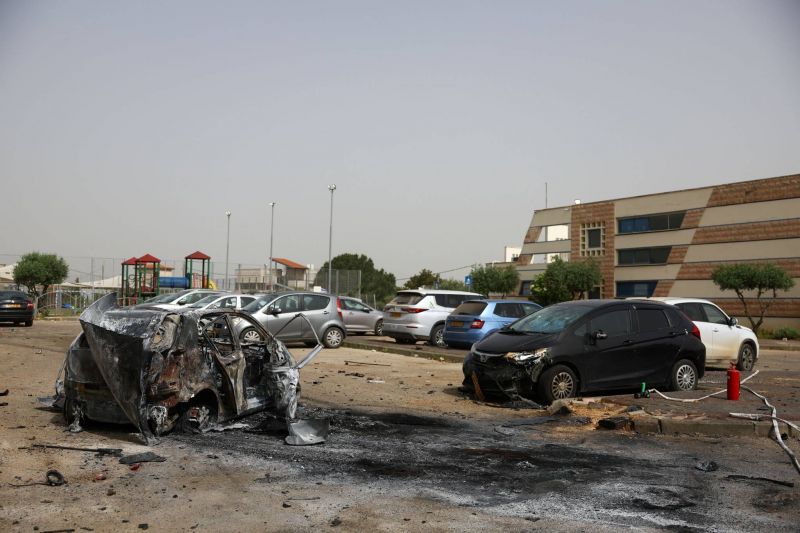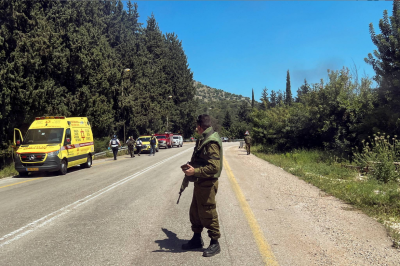
A destroyed car in front of a building struck by Hezbollah missiles in Arab al-Aramshe, in northern Israel, April 18, 2024. (Credit: Hannah McKay/Reuters)
On two occasions this week, Hezbollah managed to carry out precision strikes against northern Israel, using drones and missiles — without the famous Israeli air defense system, the Iron Dome, being activated.
On Wednesday, a Hezbollah attack on a "new military reconnaissance headquarters" in the border town of Arab al-Aramshe wounded 18 people, around 14 of them Israeli reserve soldiers.
The Israeli army said it was investigating why the Iron Dome's interceptor missiles were not launched toward the incoming Hezbollah one-way drones and guided missiles. The defense system is programmed to evaluate whether missiles will fall in civilian areas and only launch an interceptor missile when this is determined to be the case.
A similar incident occurred the previous day, in the northern Israeli village of Beit Hillel, located across the border from Houla, in Marjayoun district. Two Hezbollah drones crossed into Israeli territory without even sounding rocket alarms. According to Hezbollah, this attack enabled it to "hit Iron Dome platforms, killing and injuring people.” Haaretz reported three wounded and said the Israeli army was investigating into how the drones had managed to go unnoticed.
Elijah Magnier, former war journalist and military expert, explains to L'Orient-Le Jour how and why Hezbollah's drones managed to slip through the net.
OLJ: How do you explain the fact that Hezbollah's drones have not been intercepted by Israel on two occasions this week?
Magnier: Several factors contributed to these drones going unnoticed. Firstly, they were fired less than a kilometer from the border, which meant there was no time to intercept them. They were also flying at low altitudes, whereas the Iron Dome is better at detecting drones flying at high altitudes. They are also a new generation of Iranian drones that make no noise.
Hezbollah has all kinds of drones. It has old, very noisy machines, and second-generation ones that are quieter and can fly for several hours. It also has third-generation drones [like those used this week] that are difficult to detect by the radar and can fly for over 30 hours. These drones can carry up to 500 kg of explosives.
OLJ: Why unveil these drones now?
Magnier: We haven't seen Hezbollah's modern drones until now. By using them, the party is announcing that it still has plenty of surprises in store for Israel. The device used on Arab al-Aramshe, for example, carried a load of 50 kg of explosives, whereas a drone is usually loaded with no more than ten kilos.
When it entered this conflict, Hezbollah did not display all its military capabilities at once. Instead, it is moving in gradually. One of Hamas' mistakes was to launch 5,000 rockets at once on Oct. 7, when it was unable to maintain the same pace.
We also know that Hezbollah has advanced capabilities in terms of electronic intelligence and hardware. It can, for example, easily infiltrate telephones and spy on communications between Israeli soldiers. Despite a ban dating back to 2010, many Israeli soldiers use their cell phones on the front line.
OLJ: What message is Hezbollah trying to send to Israel?
Magnier: Until now, Hezbollah has insisted on following the rules of engagement. It was content to strike military targets to prevent the conflict from escalating. It knows that if it upsets Israel, the latter's response will be destructive.
Hezbollah is organically linked to Iran. It's trying to tell Israel that it will take part in the conflict if Israel decides to respond to Iran. In this way, Hezbollah is giving a taste of its military capabilities.
This interview was originally published in French on L'Orient-Le Jour. Translation by Amelia Hankins.
